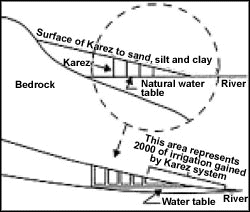
Rebuilding Karez
 For
peace to return to Afghanistan, the government has to address the issue of water
management by evolving a long term strategy on water management. The 23 years of conflict
has destroyed the country's infrastructure. For
peace to return to Afghanistan, the government has to address the issue of water
management by evolving a long term strategy on water management. The 23 years of conflict
has destroyed the country's infrastructure.
Afghanistan receive less than 300 milli meters (mm) of annual rain and in the
last five years consecutive drought has worsened the situation further. Deep drilling is
emerging as a major issue of concern. A sustainable solution to their water woes partially
lies in repairing existing karez system that has been an integral part of the irrigation
process in Iran, Afghanistan, China, Pakistan, North Africa, and the Arabian peninsula for
more than 2,500 years.
The karez irrigation system relies on gravitional pull and comprises of a water
source, underground tunnels, and vertical shafts that feed the water scarce areas.(See
diagram: A dissected view) "A vertical well is dug to tap ground water. Instead of
bringing to the surface at the site of the well, a horizontal tunnel with a gentle slope
brings the water and, it surfaces usually far away from the source," explains Biksham
Gujja, WWF International. The series of these tunnels supply water for both irrigation and
domestic purposes. These systems are owned and operated wholly by individuals and
community.
A dissected view |
 |
Besides, karez has been extensively used by the villagers as shelter against
invading armies, since medieval times. Taliban has effectively used this system as a vital
part of its guerrilla warfare. Karez is in a bad shape today, because prolonged battles
have ruined the country's agricultural system.
Reconstruction projects are being taken up by the local non-governmental
organisations with external funding. According to WWF International reports, "The
entire system could be rejuvenated for about US$ 20 million" - not a large sum if one
take into account the US$ 4.5 billion already pledged in aid. This will help in generating
rural employment for millions of people - giving peace a chance.
|
KUWAIT
Desert bloomIn
early 1960s, Kuwait successfully developed two regions - Wafra and Abdally, as major
agricultural areas. Cucumbers, eggplants and even strawberries were grown with brackish
water. But this desert bloom was on the verge of death with salinity affecting the
groundwater table.
The quality of groundwater has declined rapidly in both the regions. Experts
cautioned that "If these trends continued, agriculture here, would grind to a halt
within a decade". Intensive research conducted by the government proposed that a
proper water withdrawal technique could tap groundwater while bypassing the pockets of
salty water. The government took note of this and acted with alacrity. Local farmers
supported the process.
The efforts are now yielding dividends. The continued high yields from Kuwait's
'fruit and vegetable belt' in Wafra and Abdally, is an evident indicator. The desert that
receives less than 115 mm of annual rainfall is blooming again.
Source: TWAS Newsletter 2002, Strawberries in Kuwait, Jan - Mar |
AFRICA
Stranglehold in Africa
Under the varied legal systems prevalent in the continent of Africa,
rooftop rainwater harvesting (RWH) does not form a part of the national water management
strategy. Except in South Africa (SA). While water laws are surely not the key to promote
RWH, but they can certainly hinder it. Such consequences were faced by the people of Lava
ka baas village, Rajasthan, India. When without any reason, the authorities were all set
to destroy a community-based water harvesting strucutre.
In SA everyone has right to basic water supply and all water resources including
rainwater are treated as a property. This is in complete contrast with the legal system of
other African countries. For instance, in Uganda and Kenya, the right to own and use all
the water resources rests with the government alone. Ironically, in many of the African
nations, even when the public distribution system is not effective, permits are needed to
install rwh at household level. Rainwater is treated as state's property like any other
water resource. Further, in some countries like Kenya, Lesotho and Tanzania the ownership
of land is the condition to get a permit. In Namibia, RWH is forbidden.
Major policy functions like the right to define legal public water schemes
remain vested with the federal governments in Uganda and Tanzania.
The absence of a legal framework in many African countries is adversely affect
the sustained applicability of the process.
Source: Hartung H and Patschull C, Legal Aspects of RWH in Sub-Saharan
Africa, A research paper |
|

 For
peace to return to Afghanistan, the government has to address the issue of water
management by evolving a long term strategy on water management. The 23 years of conflict
has destroyed the country's infrastructure.
For
peace to return to Afghanistan, the government has to address the issue of water
management by evolving a long term strategy on water management. The 23 years of conflict
has destroyed the country's infrastructure. 